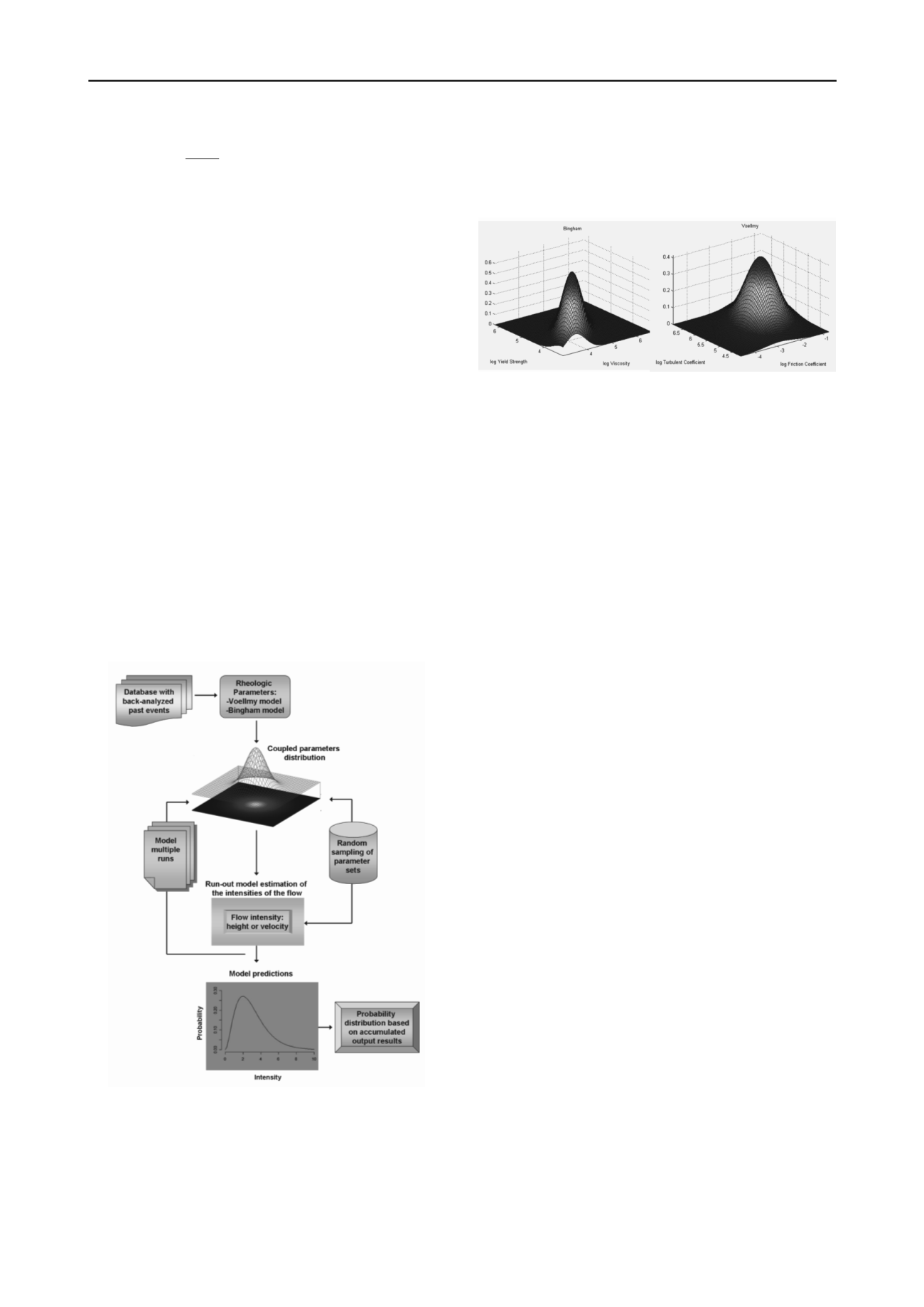
2158
Proceedings of the 18
th
International Conference on Soil Mechanics and Geotechnical Engineering, Paris 2013
2
tan
vg
app
(1)
y
(2)
where,
is the shear stress at the base of a differential column
of landslide mass,
is the normal stress at the base,
app
is an
apparent friction angle,
is the bulk density of the landslide
mass, g is the acceleration of gravity,
v
is the velocity,
is the
turbulent coefficient,
y
is the yield strength,
is the viscosity,
and
is the shear strain rate. The apparent friction angle and
the turbulent coefficient are material parameters of the Voellmy
rheology. The yield strength and the viscosity are the
corresponding parameters for the Bingham model.
The main objective of the present application of the Monte
Carlo analysis is to examine the effect of uncertainty associated
to the variability of the rheological parameters of the Voellmy
and Bingham models on the estimation of debris flow run-out.
This method allows evaluating the probability distribution of
the relevant output parameters (intensity parameters) for a
hazard assessment once the proper probability distributions for
the parameters of both rheologies have been defined. In other
words, it is possible to account explicitly and objectively for the
effect of uncertainties in the model. For the application of the
Monte Carlo analysis, each of the input parameters was
assigned a distribution. The output from the model is calculated
several times for a set of randomly selected input parameters.
This produces a probability distribution for the output values,
such that the uncertainty for the exceedance of any particular
value can be estimated. Figure 1 presents a simplified flowchart
of this procedure.
Figure 1. Flow chart of the application of a Monte Carlo method for a
probabilistic assessment of landslide run-out.
The uncertainty resulting from the physical process
(variability inherent to the phenomenon) is expressed inside the
probability density functions of the parameters characterizing
the base shear. An extensive literature study was carried out for
collecting a database of past back-analyzed landslides, including
the calibrated rheological parameters for each event. The
relationships between the parameters of the Voellmy and
Bingham rheologies were
modelled as a “Gaussian Copula” to
define the probability density function for both rheological
models (Fig. 2)
Figure 2. Fitted “Gaussian copula” distribution function to the Bingham
rheology (left) and Voellmy rhoelogy (right).
Each distribution was randomly sampled to obtain a set of
5000 pairs of rheological parameters. In the next step, a routine
was coded to repeatedly run the simulations for each pair of
parameters. At the end of each simulation, the output values of
peak intensity parameters (maximum depth and velocity) were
saved for selected points on the area of interest. Finally, the
output values were fitted to a theoretical probability density
function. The parameters for each probability distribution were
reported. In addition, the probability that the output exceeds a
particular value or will fall within a certain range was
calculated.
The dynamic run-out model MassMov2D (Begueria et al.
2009) was selected because it allows the use of scripts which
can be modified to include output reports in the form of maps or
text files. A batch file was built-in and incorporated inside
MassMov2D which selects the randomly generated sets of
parameters to produce multiple simulations. The results of each
simulation regarding the maximum flow depth and maximum
velocity at each control point were reported in a text file form
for being fitted to a theoretical probability density function.
3 STUDY CASES
3.1 The Faucon catchment in the Barcelonnette Basin
Inside the Barcelonnette Basin, the Faucon torrent was selected
as a test site. The Faucon catchment is a steep forested
watershed with an area of approximately 10.5 km
2
which rises
to 2984 m a.s.l. Most slopes are steeper than 25°, reaching 80°
at the highest elevations. Many of the slopes in the Faucon
catchment are covered by various types of Quaternary deposits:
thick taluses of poorly sorted debris; moraine deposits; screes
and landslide debris. These deposits have a sandy-silty matrix,
may include boulders up to 1–2 m in size and are between 3 and
15 m thick (Remaître 2006). The main incised channel has an
average slope of about 20°, ranging from 80° in the headwater
basin to 4° on the alluvial fan, and is approximately 5500 m in
length. Channel morphology is characterized by a V-shaped
profile with a steep channel in the upper part, and a flat-floored
cross-profile between steep slopes. The Faucon torrent has
formed a 2 km
2
debris-fan that spreads across the Ubaye valley
floor. It has a slope gradient ranging from 4 to 9°. The fan
consists mostly of cohesionless and highly permeable debris
(debris-flows strata and/or torrent deposits) (Remaître et al
2005). Two
points within the area of interest (in terms of
exposed elements) were selected on the accumulation area to
calculate the maximum flow height and the maximum velocity
(Fig. 3).


